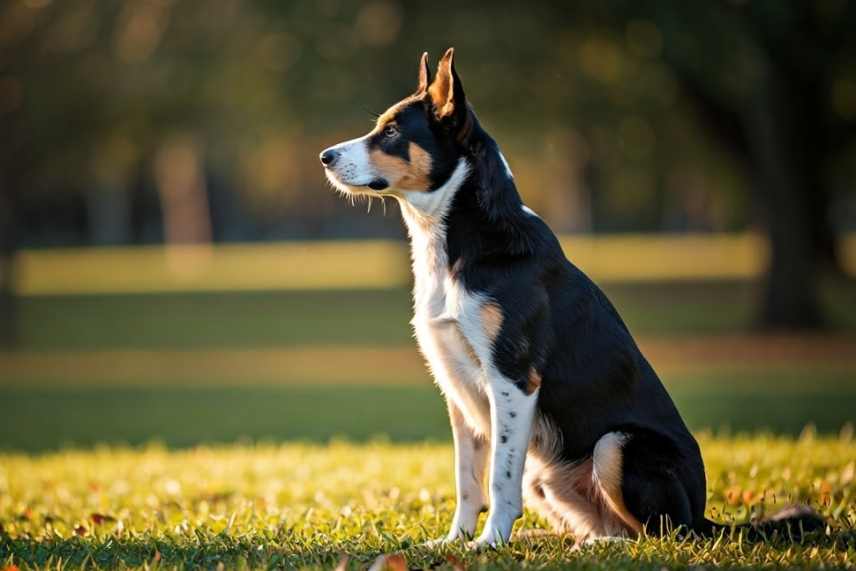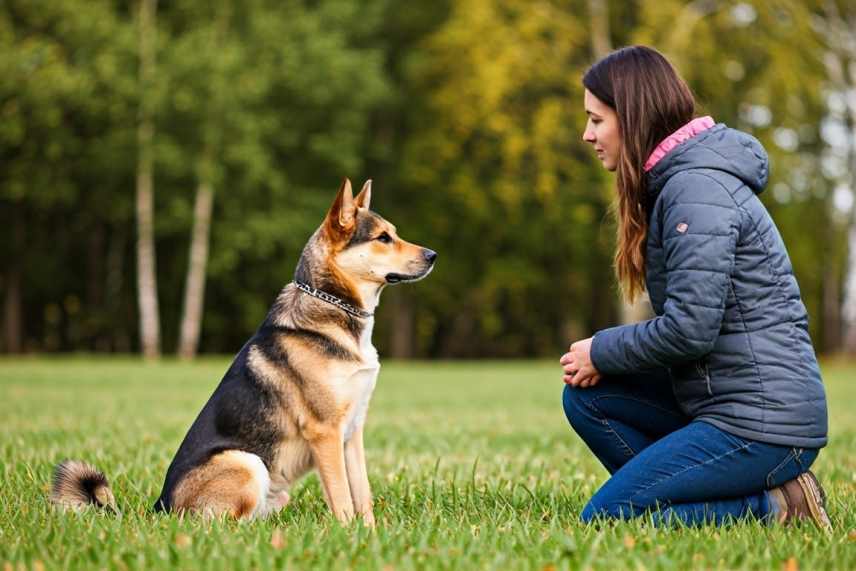
Key Highlights
- Teaching your dog the “stay” command is important for their safety and helps them listen better.
- Begin with simple commands such as “sit” before you show them the “stay” cue.
- Use positive reinforcement methods. You can reward your dog with treats and praise.
- Slowly make the training harder by increasing how long they need to stay, the distance from you, and the things around them.
- Be patient and stick to your training schedule. Your dog will learn to stay in place like a champ!
Introduction
For dog owners, teaching basic commands is very important in dog training. The “stay” command is one of the best skills you can teach. It shows your dog’s obedience and helps keep them safe. It also gives you peace of mind in different situations. This guide will show you how to teach your dog to stay. It will help both of you succeed.
Understanding the Basics of “Stay”

Teaching a dog to stay is not just about having them sit still. It’s also about clear communication so your dog knows what you want. You need to use a verbal cue, like saying “stay,” along with a hand signal. This hand signal is often an open hand, like a stop sign.
Consistency is very important during training. By always using the same words and signals, your dog will learn what actions you expect. Remember, positive reinforcement is very helpful. Celebrate every win with treats, praise, and lots of encouragement.
The Importance of Teaching Your Dog to Stay
The “stay” command is more than just basic obedience. It is very important for responsible dog training and helps keep your dog safe in many situations. For example, think about how you can keep your dog right by you near a busy road. This command also stops them from running out of an open door when you aren’t ready. These examples show why a strong “stay” is so important.
Besides safety, the stay command is very useful in everyday life. It can help make grooming easier and keep your dog calm when guests arrive.
In short, teaching your dog to stay gives them useful life skills that improve their safety and strengthen your bond. This helps create a happy and well-adjusted dog companion.
Differentiating Between “Stay” and “Wait”
While both cues help your dog stop, it’s important to know the differences between “stay” and “wait” for good training:
- “Stay” Cue: This means your dog should stay in a specific position until you give a release cue. They should remain still and focused, even if you move away.
- “Wait” Cue: This is usually for short pauses. It tells your dog to stay where they are until you give more instructions. This cue is great for daily situations, like waiting before crossing the street.
During training, your body language is very important. When using the stay cue, keep a calm and confident stance. This helps your dog understand that you want their full attention.
Preparing to Teach Your Dog to Stay
Before you begin training, it’s important to have the right tools and a good space to help you succeed. You don’t need anything special, just some basic items to make learning easier.
Also, keep in mind that patience and consistency are very important when teaching your dog new tricks. It may take time and practice for them to understand the commands. Stay positive and know that every dog learns at their own speed.
Essential Supplies for Training
Having the right tools can greatly help you in dog training. Here is what you need:
- High-Value Treats: Pick small treats that your dog loves. This will keep them motivated during training.
- A Clicker (optional): A clicker can be helpful for positive reinforcement. It makes a sound that shows your dog they did the right thing.
- A Leash: A leash is good for the early stages and when training in distracting places. It helps you guide and control your dog gently.
These basic items will help you communicate better and encourage good behavior during training. This way, your dog can have a positive learning experience.
Setting Up a Distraction-Free Training Space
When you first teach the “stay” command, choose a familiar place without much noise. This could be your living room or a calm spot in your yard, where your dog feels safe and at ease.
As your dog learns, slowly add small distractions to check their focus. This step of gradually including distractions is important for creating a strong “stay” in different places.
Keep in mind, the main goal is to help your dog succeed. By beginning with easy steps and building on their success, you will help them learn the “stay” command in a fun and positive way.
Step-by-Step Guide to Teaching “Stay”
Now that you are ready, let’s divide the “stay” training into simple steps. Take your time to progress slowly, and use positive reinforcement.
Each step is based on the one before it, making the “stay” training a bit harder each time. As your dog gets better at each step, they will feel more confident and be closer to a strong “stay.”
Step 1: Start with a Sit Command
- Start by asking your dog to sit in their starting position.
- Make sure their body language is relaxed and focused. This will create a good base for the stay.
- When your dog is sitting, clearly say the word “stay.” Use your hand signal with it.
- This mix of words and signals will help them understand what you want.
- At first, try for a short stay, just a few seconds.
- If they stay seated, give them a treat right away.
- This helps them build a positive association with the “stay” command from the beginning.
Step 2: Introduce the Stay Command
Once your dog can sit for a few seconds, you can start teaching the “stay” command. When you say “stay,” extend your hand in a clear “stop” signal.
Being consistent is very important. Always use the same words and hand signal whenever you practice. This helps your dog understand what you want.
Slowly increase how long your dog needs to stay. Add just a second or two each time. The key is to know your dog’s limits and work within them. This way, your dog can succeed at every step.
Step 3: Gradually Increase Distance and Duration
As your dog learns to stay longer, start moving back slowly while they stay in place. Increase the distance a bit at a time, and reward them for staying put.
If your dog moves from their spot, kindly move them back to the starting position and try once more. It’s important to find the right balance between challenging them and helping them succeed.
Training takes patience. The length of time your dog can stay will be different for each one. Celebrate their improvements and adjust the training to fit their own pace.
Step 4: Practice with Distractions
Once your dog can stay while you are some distance away, it’s time to add distractions. Start with small distractions. You can throw their toy lightly near them. Then, slowly add more challenges.
For example, practice the “stay” command near a curb before crossing the street. This way, you help them get used to real-life distractions over time.
Taking it step by step makes sure your dog can stay, even when things get exciting around them.
Step 5: Incorporate the Release Command
The last step is to teach a clear release cue, like “okay” or “release.” This tells your dog they are free to move. The release word marks the end of the stay command.
When you want to end the stay, say your chosen release word clearly. Encourage your dog to get up. Using a consistent release cue helps them understand better and avoids confusion.
This final step changes how they see “stay.” It becomes a clear command with a clear start and finish.
Common Challenges and Solutions
Even with careful planning, it’s normal to face some problems during training. Understanding these common issues and finding good ways to solve them can help keep your training steady.
Stay upbeat and see these challenges as chances to learn, for you and your dog. By changing your method and staying calm and consistent, you will handle these problems easily and keep moving toward success.
Addressing Early Breaks from Stay
If your dog keeps breaking their stay, go back to the earlier steps. Patience and consistency are very important. Do not use harsh corrections because they can mess up their learning.
When your dog breaks, calmly bring them back to the starting position. You should also shorten the duration or distance to help them succeed.
Creating a strong stay takes time and practice. By using positive reinforcement and changing the training to match their pace, you will see slow but steady improvements.
Progressing Training in Different Environments
Once your dog can stay well in one place, start training in new locations. Practicing in different environments helps your dog understand the command better and deal with different distractions.
Make sure you stay consistent with your signals and rewards. Using the same hand signs and words gives your dog a sense of comfort when they face new challenges.
By slowly introducing them to new places, you improve their training experience. This way, their “stay” will stay strong, no matter where they are.
Conclusion: How Do I Teach My Dog to Stay
In conclusion, teaching your dog to stay is an important skill. It helps with obedience and safety. You can teach your dog to stay by using a clear training plan and being consistent. Make sure to train in a place without distractions. Use positive reinforcement to encourage your dog. Gradually, you should increase the distance and duration of the command for better learning. Patience and practice are essential to getting better at this command. This also helps you grow closer to your pet. Enjoy the journey and celebrate each small step your dog takes in learning to stay. Start this rewarding path today!
What are some effective techniques for teaching a dog to stay?
To teach your dog to stay, start with short distances and durations, gradually increasing both. Use positive reinforcement like treats, praise, and consistency. Practice in a quiet space to minimize distractions, and release with a command like “okay” to teach when they can move.
Free Online Dog Obedience Training: Top Resources for Training Your Canine at Home

One of the biggest advantages of free online dog obedience training is the ability to learn at your own pace. Unlike traditional dog training classes, which may have set schedules and agendas, online training allows dog owners to work with their dogs on their own time. This can be especially helpful for busy dog owners who may not have the time or flexibility to attend regular training classes.
Continue reading: Free Online Dog Obedience Training
Online Dog Training Courses: Master the Art of Dog Training from the Comfort of Your Home

The convenience of online courses means you can learn at your own pace and fit training sessions into your schedule, no matter how busy you are. Plus, with interactive videos, demonstrations, and instructional materials, you’ll have all the tools you need to succeed.
Continue reading: Online Dog Training Courses

